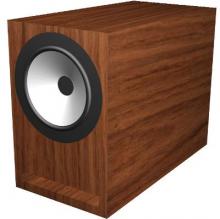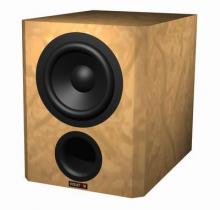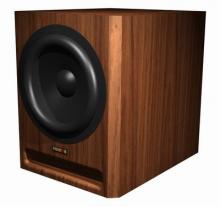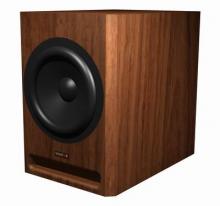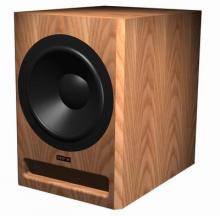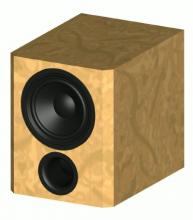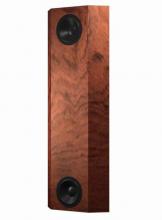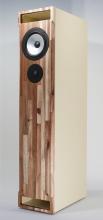Subwoofer
GRAND ORGUE
The toughest challenge for a high-end loudspeaker is to reproduce the lowest frequencies of larger instruments, such as an organ or double bass, with appropriate fidelity. Only very few speakers are at all able to reproduce the lowest register of a church organ and even then only the very best are able to make it sound as if it was coming from an organ pipe. To do credit to a double bass in all its glory without sounding fluffy or over-inflated or, even worse, giving up altogether, is the reserve of very few, outstanding loudspeaker constructions. The "Les Orgues" speaker series, in this case the GRAND ORGUE species, represent exactly that capability. With eight WS 25 E - 8 Ohm woofers, optimised specifically as a free-air system, mounted in a folded, but open baffle, they are able to reproduce bass down to below 20 Hz in a most natural, unhurried and completely unexaggerated manner and with no sign of weakness. Since there is, in effect, no enclosure, the resonant frequency of the woofer is not increased, but in this case even decreased, which enables it to emanate clear, non-compressed extremely low frequencies. The precondition for this low-range bass imaging, which uses double-sided radiation, is, however, also to ensure the speakers are far enough away from the wall. One metre is sufficient, but for full power right to the bottom of the bass range, 2 - 3 metres is preferable.
But the effortless and unobtrusive deep bass is not all, by any means. The bass section, which radiates to both sides, is supplemented by a line array consisting of eight oval SL 713 - 4 Ohm full-range drivers. This moderately priced full-range loudspeaker is characterised by its extremely light paper diaphragm and the voice coil carrier made of kraft paper which, together, ensure absolutely natural sound right through to the highest frequencies.
A key characteristic of line arrays is that they generate a highly focused sound beam in the vertical plane. Outside that main path, a large proportion of the signal is cancelled out by interference. This prevents reflections from the floor and ceiling from even coming into existence, which would impair the precise tridimensional imaging of the music. However this beaming effect is a direct function of the wavelength of the sound radiated. The higher the frequency, and, as a result, the shorter the wavelength, the more extreme the beaming effect. A large array such as we have here in the GRAND ORGUE would normally lead to very extreme beaming in the high-frequency range, which would not reflect the reality of the sound being played. To achieve as uniform a beaming effect as possible across the entire frequency range, which is important to guarantee balanced sound quality in the listening room, we have arranged for a correcting circuit within the array. This circuit ensures that, as the frequency increases, additional output is directed towards the second and third full-range drivers from the top while the output to the other six drivers is gradually reduced. In effect, the array is shortened across the full range steplessly from eight loudspeakers to two. These two loudspeakers should be as close as possible to ear height. If ear height should actually be higher or lower than the midpoint between the second and third full-range drivers from the top, the system can easily be adapted to the situation by wiring up the array in such a way that e.g. the third and fourth drivers from the top are responsible for the higher frequencies. In this way, the cabinet can be tuned in small steps to suit the real situation.
Combining all these technical sophistications in a single cabinet results in an exceptional speaker system which is predestined for the "natural" reproduction of music, but not only for that. Whether it is a keenly picked guitar string, a crisp drum solo, an entire symphony orchestra including an uplifting, heart-warming string section and a powerful brass department, or the veritable queen of all instruments, the organ, it will all come across absolutely authentically, with dynamism and is guaranteed to give you goose pimples. In the same way, voices, male and female, are reproduced faithfully including every tiny detail. Each instrument and voice appear to be hovering in exactly the right place in space, the spatial quality is completely natural and everything is in the defined position.
Anyone on the lookout for loudspeakers for high-quality music, who does not intend to make compromises in terms of frequency response and who is keen on extremely accurate imaging of the stage or orchestra pit, should take a close look at the GRAND ORGUE. The only preconditions are a powerful amplifier and generous distances between the cabinets and the walls to enable the GRAND ORGUE to develop its capabilities.
HINT: The bass part of the GRAND ORGUE, on its own without the full-range drivers, connected directly up to an active source without a passive crossover, acts as an excellent subwoofer and can be used, either singly or as a pair, to support music-orientated high-end loudspeakers and full-range loudspeakers down to the lowest bass frequencies and give home theatres the bottom end that they deserve.
MINI SUB 170
A compact subwoofer is usually a compromise between keeping the outer dimensions to a minimum and producing adequate bass sound. To ensure that the tidy size for use in the living-room does not impair one's listening pleasure, a certain minimum cabinet volume is essential. The 15 litres available in the MINI SUB 170 have been realised in a cabinet that is only 20 cm wide. With its depth of 39 cm and a height of 30 cm, the MINI SUB 170 will easily find a space beside, on or even under any piece of furniture of standard dimensions.
The long-excursion aluminium AL 170 - 8 Ohm woofer generates no less than 85 dB (at a distance of 1 metre) in conjunction with the front bass reflex vent at one watt and from 65 Hz. Within the range from 40 Hz to 70 Hz, the series-connected 800-µF capacitor raises the output level by a further 2 dB. As a result, this small-sized speaker cabinet sounds far more grown-up than its physical size would suggest.
The MINI SUB 170 is a perfect complement to a compact satellite system (stereo and home theatre) or PC speakers which are often sadly lacking in the bass department. In other words, it will always be suitable where a chunky subwoofer monster will either not fit or is not desirable but you do not want to do without a solid low-frequency musical foundation.
PETIT ORGUE
The toughest challenge for a high-end loudspeaker is to reproduce the lowest frequencies of larger instruments, such as an organ or double bass, with appropriate fidelity. Only very few speakers are at all able to reproduce the lowest register of a church organ and even then only the very best are able to make it sound as if it was coming from an organ pipe. To do credit to a double bass in all its glory without sounding fluffy or over-inflated or, even worse, giving up altogether, is the reserve of very few, outstanding loudspeaker constructions. The "Les Orgues" speaker series, in this case the "Petit Orgue" species, represent exactly that capability. With their WS 25 E - 8 Ohm woofers, optimised specifically as a free-air system, mounted in a folded, but open baffle, they are able to reproduce bass down to below 20 Hz in a most natural, unhurried and completely unexaggerated manner and with no sign of weakness. Since there is, in effect, no enclosure, the resonant frequency of the woofer is not increased, which enables it to emanate clear, non-compressed extremely low frequencies.
In contrast to conventional loudspeaker cabinets in which it is the sheer size that determines, to a large extent, their capability to produce very low frequencies, the "Petit Orgue" can indeed compete with its big brother, the "Grand Orgue", in terms of depth. The differences between them are limited, in the main, to the sensitivity and maximum volume level, while the lower limiting frequency is identical. You have to actually hear with your own ears how this unassuming little speaker pumps those deep-black sound waves around the listening room before you can believe it. It may be that the maximum volume level is restricted, but the very fact that it is able to produce lower bass frequencies than most of the larger column speakers is more than impressive.
The precondition for this low-range bass imaging, which uses double-sided radiation, is, however, to ensure the speakers are far enough away from the wall. One metre is sufficient, but for full power right to the bottom of the bass range, 2 - 3 metres is preferable. It is, therefore, not really feasible to use the "Petit Orgue" as a shelf-mounted solution, despite its modest size.
As in the big brother, oval SL 713 - 4 Ohm full-range drivers are responsible for the range above 300 Hz. This moderately priced full-range loudspeaker is characterised by its extremely light paper diaphragm and the voice coil carrier made of kraft paper which, together, ensure absolutely natural sound right through to the highest frequencies. Since only two of them are in use here, there is no need for separate controllers. It is a good idea, however, to use suitable stands to raise the "Petit Orgue" speakers to ear height because the two full-rangeloudspeakers radiate their output as a beam.
The tonality of these speakers is comparable to that of the "Grand Orgue": highly authentic, direct, dynamic. The bass is incredibly deep and yet retains unobtrusive clarity. With the "Petit Orgue", low-frequency instruments, powerful orchestral moments and voices come across absolutely authentically and with a large portion of live atmosphere. The image of the orchestral layout is clearly defined and focussed, even if, as a result of the construction principle, it cannot quite reproduce the exceptional precision of which the "Grand Orgue" with its 8-fold array is capable.
Be that as it may, the "Petit Orgue" is far more than just a baby brother. It is indeed a fully-fledged high-end loudspeaker system that is designed to appeal to listeners who may not need absolute top-of the range volume levels but who do require deep black crisp bass and extremely authentic instrument layout.
Hint: The bass part of the "Petit Orgue", on its own without the full-rangedrivers, connected direct up to an active source without a passive crossover, acts as an excellent subwoofer and can be used, either singly or as a pair, to support music-orientated high-end loudspeakers and full-range loudspeakers down to the lowest bass frequencies.
SUB T-20.39
The compact SUB T-20.39 subwoofer makes use of the same cabinet as the SUB W-20.39. In contrast, it uses the more powerful TIW 200 XS - 8 Ohm high-end woofer. The TIW 200 XS - 8 Ohm, designed through and through as a long-stroke driver, achieves an even lower level of limiting frequency and an increase in level accuracy. Its bass reproduction is exceptionally clear-cut.
As a result, the SUB T-20.39 is suitable for inclusion in small and medium-sized, high-grade speaker cabinets (e.g. ARIA, ARIA 2, COUPLET ), whether stereo or multi-channel systems. It is powerful enough to deliver hard-hitting bass attacks in normal rooms but is still highly compact in terms of its external dimensions.
A complete kit for this suggestion is available via www.vc-mailorderservice.de.
SUB T-25.30
For the high-end TIW 250 XS - 8 Ohm woofer we recommend one of two cabinet sizes: either a small, space saving version with a net volume of 30 litres (SUB T-25.30) or a somewhat larger version with 50 litres net volume and a lower tuning (SUB T-25.50).
As one would expect, the SUB T-25.50 provides warmer, deeper bass, and the lower limiting frequency is 25 Hz, considerably lower than for the SUB T-25.30. But it is particularly in smaller rooms that the 30 litre version comes into its own. The missing low-bass (approx. 3 dB at 35 Hz) can easily be compensated for by applying a little electronic bass boost. Of course, the maximum volume level will be slightly lower as a result.
A complete kit for this suggestion is available via www.vc-mailorderservice.de.
SUB T-25.50
For the high-end TIW 250 XS - 8 Ohm woofer we recommend one of two cabinet sizes: either a small, space saving version with a net volume of 30 litres (SUB T-25.30) or a somewhat larger version with 50 litres net volume and a lower tuning (SUB T-25.50).
As one would expect, the SUB T-25.50 provides warmer, deeper bass, and the lower limiting frequency is 25 Hz, considerably lower than for the SUB T-25.30. But it is particularly in smaller rooms that the 30 litre version comes into its own. The missing low-bass (approx. 3 dB at 35 Hz) can easily be compensated for by applying a little electronic bass boost. Of course, the maximum volume level will be slightly lower as a result.
A complete kit for this suggestion is available via www.vc-mailorderservice.de.
SUB T-30.60
The SUB T-30.60 has been developed as a support for high-performance systems. The TIW 300 - 8 Ohm woofer used here with its large, multi-vented voice coil, is of a design which enables it to work at high output levels and still maintain clear, precise sound. In the recommended cabinet, it manages a very impressive sound pressure of 89 dB (1 W/1 m) at 30 Hz lower limiting frequency.
The recommended cabinet has 60 litres net volume and is still compact enough to integrate easily in most living rooms. The large-format bass reflex tube effectively suppresses flow losses and flow noise. To guarantee the rigidity of the cabinet, the floor and front panel are double and with additional strengthening struts.
A complete kit for this suggestion is available via www.vc-mailorderservice.de.
SUB W-20.39
The SUB W-20.39 is the ideal subwoofer for boosting the bass output of smaller or medium-sized speakers. On the one hand, it is powerful enough to generate driving low-range bass effects in normal rooms and, on the other hand, highly compact. In large rooms or if extremely high bass output is required for longer periods, a second subwoofer of the same type can be added.
If the SUB W-20.39 is to be used in the vicinity of a TV set, then instead of the W 200 S - 4 OHM, we recommend using the magnetically shielded W 200 SC - 4 OHM. This prevents the TV being distorted by the magnetic scatter field.
In addition, it is also possible to use the 8 ohm version of the woofer (W 200 S - 8 OHM, W 200 SC - 8 OHM) if the amplifier used does not allow lower impedance speakers to be connected or if several subwoofers are to be combined.
Not available as a complete kit.
TL-SUB 30
The subwoofer TL-SUB 30 is suitable for highly accurate soundreproduction of the deepest bass in the subsonic zone. If you are prepared and able to give up about half a cubic metre of sitting-room space and are even thinking of rearranging the furniture, the TL-SUB 30with its ultra-low bass is just what you are looking for. One thing has to be said right from the start: the bass churned out by this system at the lowest octave level is by no means the thumping disco bass that hits you right in the stomach, but is, on the contrary, as smooth as cream. It is not locatable in the room and is felt as a sort of air movement that makes your trouser legs move. The ultra-low bass give you a fascinating feeling of being there live - provided, of course, the software has the channel programmed into it.
As regards the speaker construction, we have a double transmission line equipped with two a TIW 300 - 8 Ohm. By not damping the cabinets, tremendous efficiency has been achieved, which, if the speakers are positioned in the corners, will attain levels of 114 dB at 20 Hz and a maximum sound pressure of 121 dB from 30 Hz. The output level is restricted by the mechanical construction of the speakers, to prevent the mechanical load from exceeding 200 W. We recommend combining the system with an active subwoofer module with a cut-off frequency of 50 Hz and, preferably with a subsonic filter in the pre-amp to protect the loudspeakers against mechanical overloading below 15 Hz.
This definitive lowest-range subwoofer is also suitable for supplementing larger home video applications for large rooms and small cinemas. The subwoofer can equally well be positioned upright in a corner of the room or lying in front of a wall of the room. It might be said that the reproduction of that last octave of bass sound is something of a luxury, considering the expense, but real music and home video aficionados will welcome the uncompromising approach of this system. The TL-SUB 30 generates "deep black" bass that will set the house rocking on its foundations and turns films that use this technology into unforgettable experiences.
VIB 170 BP
When developing the VIB 170 BP, the main objective was to create a fairly compact column speaker with an extremely deep bass output, which is capable of reproducing the deepest regions of the audible frequencyspectrum. A common bassreflex housing can reach this aim only partly. Therefore, a very rare type of cabinet has been realized, at least when looking at fullrange-loudspeakers: A double-sided ventilated bandpass. In this layout, a woofer which is mounted on an inner separation wall, is operating on two bassreflex-tuned volumes, a larger one and a smaller one. By means of a subtle tuning of the two cavities, a linear frequency response down to 35 Hz (-3 dB) could be obtained with a housing of only 75 liters. Not until then, the sound pressure level starts to drop rather quickly. The lower cut-off frequency (-10 dB) is located around 24 Hz. Some very large bassreflex speakers are capable of reaching similar cut-off frequencies, but the SPL already starts dropping at much higher frequencies. This is why those kinds of loudspeakers sound less voluminous and deep.
Due to the exceptionally high excursion limit of the TIW 200 XS - 8 Ohm, the maximum obtainable sound pressure level is already physically tangible and more than sufficient even for large listening rooms.
Another design feature of the VIB 170 BP is the wide frequency range of the AL 170 - 8 Ohm. By means of a sophisticated crossover set-up, we have been successful in taking advantage of the outstanding acoustical properties of the AL 170 - 8 Ohm from 100 Hz up to 8 kHz. Not until then, the established ceramic tweeter KE 25 SC - 8 Ohm takes over to render the uppermost 1-2 octaves. By this layout, the widest part of the audible spectrum is reproduced by only one driver, which helps acoustical imaging and leads to a strikingly precise stage arrangement.
So how does such a fancy build sound like? Like the best of both worlds: The spatial precision and dynamic of a good fullrange driver, paired with the brute bass power of the TIW 200 XS - 8 Ohm in the bandpass cabinetand the silky, delicate treble of the excellent ceramic calotte.
At the same time, the whole loudspeaker plays all of a piece and acts absolutely neutral in terms of tonality. Moreover, not a hint of the often-cited "sponginess" of the bandpass principle could be observed, far from it: the low tones sound firm and massive, fully grown, thus becoming to many a much larger boxes.
All around, the VIB 170 BP can be said to be a felicitous loudspeaker, which combines the advantages of a high class fullrange speaker, a multiple way box and a strong subwoofer in one slim cabinet.
TIP: The low frequency part of the VIB 170 BP, without the tweeter and the midwoofer, and without the crossover network, makes a superb subwoofer to complement even large home cinema systems, single- or pairwise.
